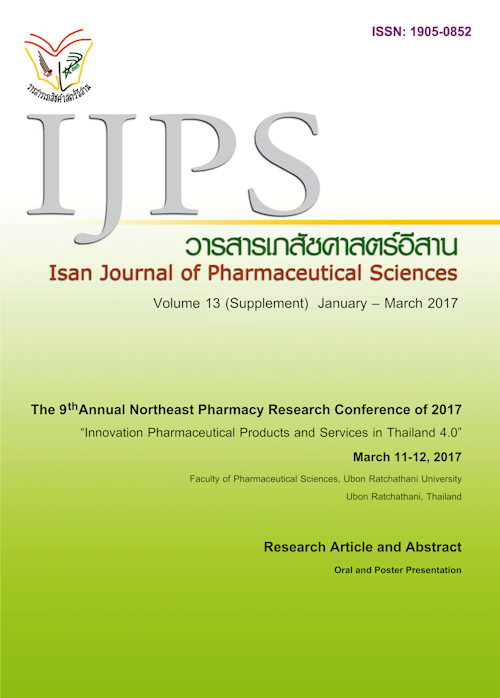Medication Possession in Patients with Diabetes and Hypertension at Community Hospital
Main Article Content
Abstract
Introduction: The medication possession beyond necessity is one of the problems in health system. Based on the campaign "New egg in exchange of unused medicines", which was initiated by; the Ministry of Public Health in 2012, including numerous studies reflected that the majority of the unused medicines comprised the prescription for chronic diseases. Main cause of medication possession was drug used behavior. There were few studies showed medication possession caused by dispensing more than necessary. This study was aimed to examine the size, value of medicines and factors that lead to medication over possession in patients with diabetes and hypertension at one community hospital. Methods: Retrospective medical records of 2,918 patients with diabetes or hypertension from April - September, 2014 were retrieved. The size and value of medication over possession was calculated by Medication possession ratio (MPR) and analyzed its statistical significance using Chi-square and Spearman's correlation coefficeint. Results: 74.61 percent of patients had medication over possession. The medication possession ratio among most patients (41.60 percent) was 1:05-1:10. The sales value of medication over possession was 91,200.46 Thai Baht. Factors affecting the medication over possession with statistical significance (p-value <0.05) were age, number of chronic diseases and the number of chronic drugs. Conclusion: Although most patients had the medication over possession, the size of medication over possession was not high (about 5 weeks per year). This study only focused on that the medication possession due to dispensing over the appointment date. Therefore, the real solution to the problem should further explore the root cause of medication possession in terms of the patient behavior through many avenues e.g. the campaign to bring the drug to the hospital at all times, counseling and refilled medication system.
Article Details
In the case that some parts are used by others The author must Confirm that obtaining permission to use some of the original authors. And must attach evidence That the permission has been included
References
Sirilak S, Ekachampaka P, Wattanamano N. Thailand Health Profile Report 2008-2010. Bureau of Policy and Strategy, Ministry of Public Health 2011; 153-155, 285.
Kessomboon N, Sukulbumrungsil R, Kanchanapiboon I, et al. Research and Systems Development for National Drug Account. Nonthaburi: Food and Drug Administration National Drug Account; 2012. 8-9.
Suwannaprom P, Niamhun N, Champoonot P et al. Items and value of household leftover medicines for chronic conditions at Sansai-Luang Sub-district, Sansai District, Chiang Mai Province. TPHSJ2012; 7(1): 22-28.
Pooviboonsuk P, editor. The threat of leftover medicines. TMJ 2010; 11(144): 12-14.
Champunot P. Leftover medicines and medicine use behavior of people in Chiang Mai Province. [Master of Pharmacy (Pharmacy Management)]. Chiang Mai: Chiang Mai University; 2010.
Health News. ‘Eggs in exchange for drugs’ has claimed 36 million tablets ‘Diabetes o Pressure - fat’ most. Thai Rath. [serial online]. 2012 Jul 10 [cited 2013 Sep 3] Available from: http://www.thairath.co.th/content/274726.
Jeanpeerapong N. et al., The estimate economic loss of leftover medicine in patients with chronic diseases. [Online]. 2008 Jul 3 [cited 2013 Sep 21]; Available from: http://kb.hsri.or.th/dspace/handle/11228/2213
Chaiyakunapruk N, Nimpitakpong P, Dilokthornsakul P, et al. The size and fiscal impact of medication over possession, solving problem by policy. Phitsanulok: Center of Pharmaceutical Outcomes Research (CPOR) Faculty of Pharmaceutical Sciences Naresuan University; 2012.
Thavornwattanayong W, Geesittisomboon W, Jansuriyakul W, et al. Survey of leftover drugs and drug use behavior among patients with chronic diseases in Nong Pak Long, Mueang Nakhon Pathom. JHS 2012; 21(6): 1140-8.


